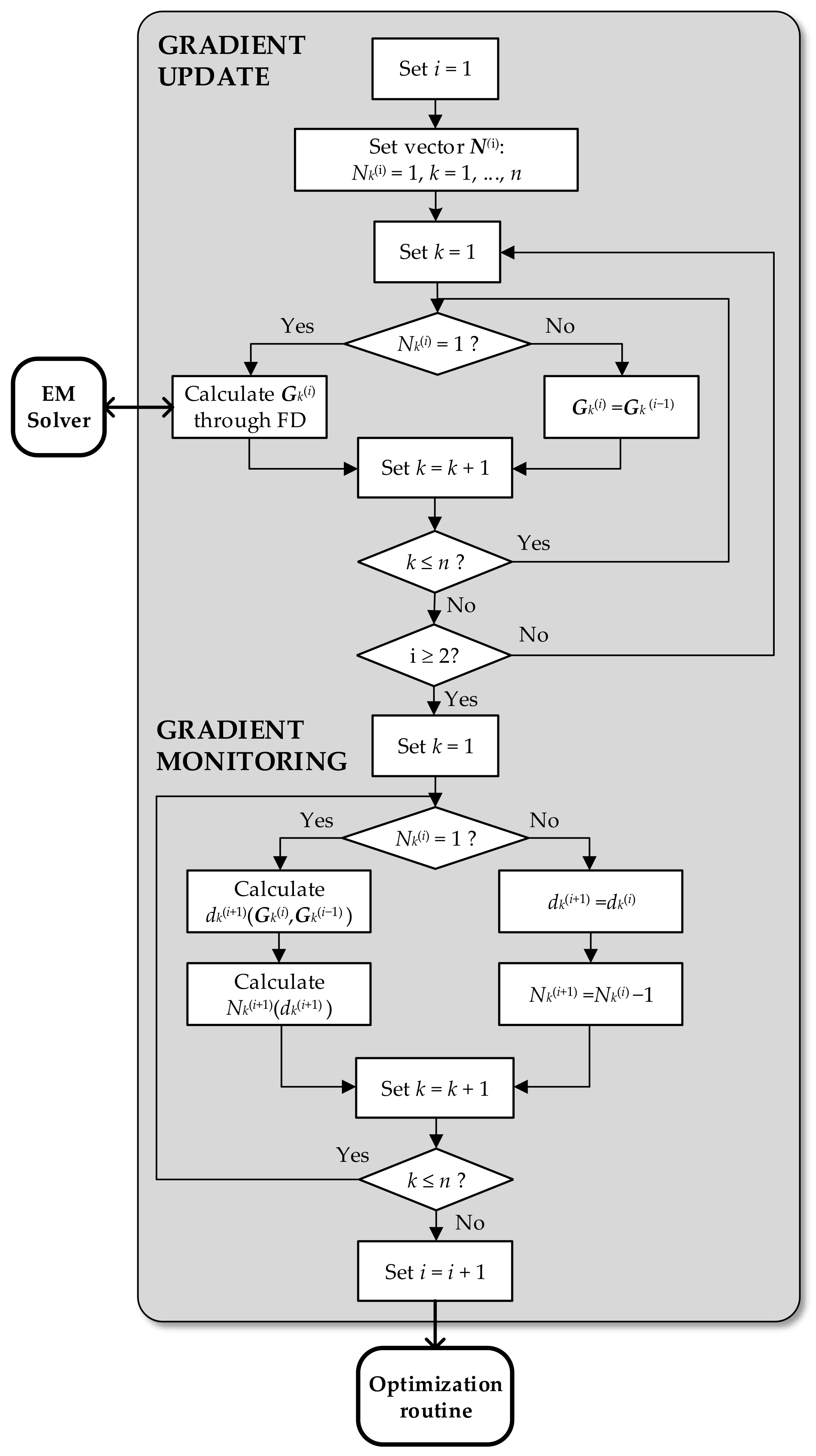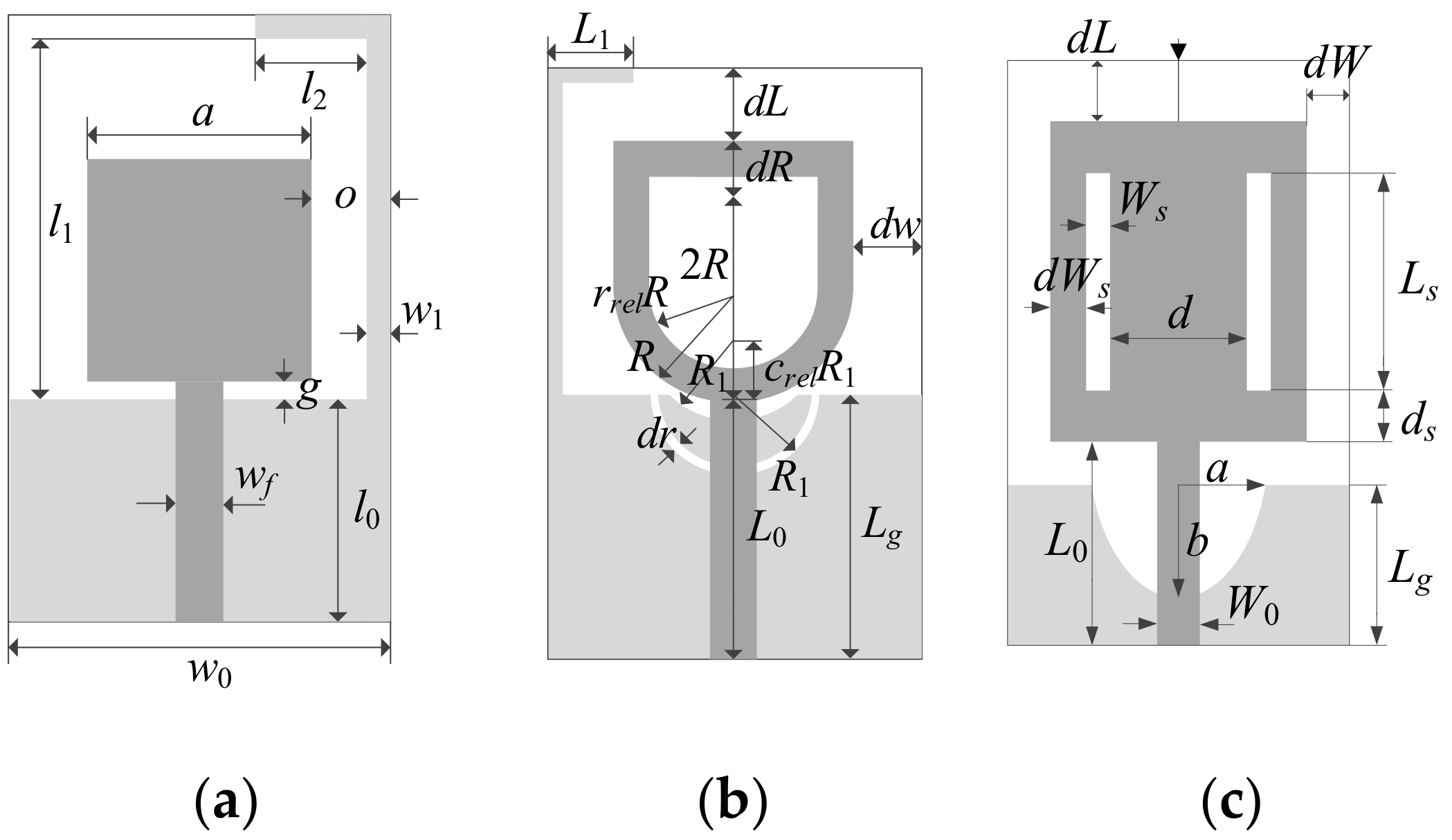Variable-Fidelity Simulation Models and Sparse Gradient Updates for Cost-Efficient Optimization of Compact Antenna Input Characteristics
Abstract
1. Introduction
2. Expedited Antenna Optimization Using Variable-Fidelity Trust-Region Search with Gradient Monitoring
2.1. Antenna Design as Optimization Task
2.2. Trust-Region Gradient Search
2.3. Variable-Fidelity Simulation Models
2.4. Proposed Optimization Framework
- d(i) = [d1(i) … dn(i)]T—a vector of gradient difference factors (cf. (5)) used in the i-th iteration,
- dmin(i) = min{k = 1,…,n: dk(i)}, dmax(i) = max{k = 1,…,n: dk(i)}.
3. Verification Case Studies and Benchmarking
3.1. Case Studies
- Antenna I: high-fidelity model (~800,000 mesh cells, simulation time 3.8 min = 230 s), low-fidelity model (~180,000 mesh cells, simulation time 77 s).
- Antenna II: high-fidelity model (~830,000 mesh cells, simulation time 3.5 min = 210 s), low-fidelity model (~280,000 mesh cells, simulation time 88 s).
- Antenna III: high-fidelity model (~520,000 mesh cells, simulation time 2.9 min = 176 s), low-fidelity model (~170,000 mesh cells, simulation time 79 s).
3.2. Experimental Setup
3.3. Results and Benchmarking
4. Discussion
5. Conclusions
Author Contributions
Funding
Acknowledgments
Conflicts of Interest
References
- Caytan, O.; Lemey, S.; Agneessens, S.; Vande Ginste, D.; Demeester, P.; Loss, C.; Salvado, R.; Rogier, H. Half-mode substrate-integrated-waveguide cavity backed slot antenna on cork substrate. Ant. Wirel. Propag. Lett. 2016, 15, 162–165. [Google Scholar] [CrossRef]
- Bashir, U.; Jha, K.R.; Mishra, G.; Singh, G.; Sharma, S.K. Octahedron-shaped linearly polarized antenna for multistandard services including RFID and IoT. Trans. Ant. Propag. 2017, 65, 3364–3373. [Google Scholar] [CrossRef]
- Zhang, J.; Shen, Z. Compact and high-gain UHF/UWB RFID reader antenna. Trans. Ant. Propag. 2017, 65, 5002–5010. [Google Scholar] [CrossRef]
- MMao, Y.; Guo, S.; Chen, M. Compact dual-band monopole antenna with defected ground plane for Internet of things. Iet. Microw. Ant Propag. 2018, 12, 1332–1338. [Google Scholar] [CrossRef]
- SShafique, K.; Khawaja, B.A.; Daniyal Khurram, M.; Maaz Sibtain, S.; Siddiqui, Y.; Mustaqim, M.; Chattha, H.T.; Yang, X. Energy harvesting using a low-cost rectenna for Internet of Things (IoT) applications. IEEE Access 2018, 6, 30932–30941. [Google Scholar] [CrossRef]
- Lemey, S.; Castel, T.; Van Torre, P.; Vervust, T.; Vanfleteren, J.; Demeester, P.; Vande Ginste, D.; Rogier, H. Threefold rotationally symmetric SIW antenna array for ultra-short-range MIMO communication. IEEE Trans. Ant. Propag. 2016, 64, 1689–1699. [Google Scholar] [CrossRef]
- Narbudowicz, A.; Ammann, M.J. Low-cost multimode patch antenna for dual MIMO and enhanced localization use. IEEE Trans. Ant. Propag. 2018, 66, 405–408. [Google Scholar] [CrossRef]
- Su, Z.; Klionovski, K.; Bilal, R.M.; Shamim, A. A dual band additively manufactured 3-D antenna on package with near-isotropic radiation pattern. IEEE Trans. Ant. Propag. 2018, 66, 3295–3305. [Google Scholar] [CrossRef]
- Liu, H.; Cheng, Y.; Yan, M. Electrically small loop antenna standing on compact ground in wireless sensor package. IEEE Ant. Wirel. Propag. Lett. 2016, 15, 76–79. [Google Scholar] [CrossRef]
- Lizzi, L.; Ferrero, F. Use of ultra-narrow band miniature antennas for internet-of-things applications. Electr. Lett. 2015, 51, 1964–1966. [Google Scholar] [CrossRef]
- Dong, Y.; Choi, J.; Itoh, T. Folded strip/slot antenna with extended bandwidth for WLAN application. IEEE Ant. Wirel. Propag. Lett. 2017, 16, 673–676. [Google Scholar] [CrossRef]
- Li, G.; Huang, Y.; Gao, G.; Wei, X.; Tian, Z.; Bian, L. A handbag zipper antenna for the applications of body-centric wireless communications and Internet of Things. IEEE Trans. Ant. Propag. 2017, 65, 5137–5146. [Google Scholar] [CrossRef]
- Jha, K.R.; Bukhari, B.; Singh, C.; Mishra, G.; Sharma, S.K. Compact planar multistandard MIMO antenna for IoT applications. IEEE Trans. Ant. Propag. 2018, 66, 3327–3336. [Google Scholar] [CrossRef]
- Fernandez Pantoja, M.; Rubio Bretones, A.; Gomez Martin, R. Benchmark antenna problems for evolutionary optimization algorithms. IEEE Trans. Ant. Propag. 2018, 55, 1111–1121. [Google Scholar] [CrossRef]
- Chamaani, S.; Abrishamian, M.S.; Mirtaheri, S.A. Time-domain design of UWB Vivaldi antenna array using multiobjective particle swarm optimization. IEEE Ant. Wirel. Prop. Lett. 2010, 9, 666–669. [Google Scholar] [CrossRef]
- Darvish, A.; Ebrahimzadeh, A. Improved fruit-fly optimization algorithm and its applications in antenna array synthesis. IEEE Trans. Ant. Prop. 2018, 66, 1756–1766. [Google Scholar] [CrossRef]
- Goudos, S.K.; Siakavara, K.; Samaras, T.; Vafiadis, E.E.; Sahalos, J.N. Self-adaptive differential evolution applied to real-valued antenna and microwave design problems. IEEE Trans. Ant. Propag. 2011, 59, 1286–1298. [Google Scholar] [CrossRef]
- El-Hana Bouchekara, H.R.; Orlandi, A.; Al-Qdah, M.; de Paulis, F. Most valuable player algorithm for circular antenna arrays optimization to maximum sideloba levels reduction. IEEE Trans. Ant. Propag. 2018, 60, 1655–1661. [Google Scholar]
- El Sabbagh, M.A.; Bakr, M.H.; Bandler, J.W. Adjoint higher order sensitivities for fast full-wave optimization of microwave filters. IEEE Trans. Microw. Theory Tech. 2006, 54, 3339–3351. [Google Scholar] [CrossRef]
- Ghassemi, M.; Bakr, M.; Sangary, N. Antenna design exploiting adjoint sensitivity-based geometry evolution. Iet Microw. Ant. Prop. 2013, 7, 268–276. [Google Scholar] [CrossRef]
- Toivanen, J.I.; Rahola, J.; Makinen, R.A.E.; Jarvenpaa, S.; Yla-Oijala, P. Gradient-based antenna shape optimization using spline curves. Ann. Rev.Prog. Appl. Comp. Electromagnet. 2010, 1, 908–913. [Google Scholar]
- CST Microwave Studio, Ver. 2018; Dassault Systemes: Vélizy, France, 2018.
- Koziel, S.; Ogurtsov, S. Antenna Design by Simulation-Driven Optimization. Surrogate-Based Approach; Springer: New York, NY, USA, 2014. [Google Scholar]
- Koziel, S.; Bekasiewicz, A. Multi-Objective Design of Antennas Using Surrogate Models; World Scientific: Singapore, 2016. [Google Scholar]
- Simpson, T.W.; Pelplinski, J.D.; Koch, P.N.; Allen, J.K. Metamodels for computer-based engineering design: Survey and recommendations. Eng. Comput. 2001, 17, 129–150. [Google Scholar] [CrossRef]
- Koziel, S.; Leifsson, L. Simulation-Driven Design by Knowledge-Based Response Correction Techniques; Springer: New York, NY, USA, 2016. [Google Scholar]
- Queipo, N.V.; Haftka, R.T.; Shyy, W.; Goel, T.; Vaidynathan, R.; Tucker, P.K. Surrogate-based analysis and optimization. Prog. Aerosp. Sci. 2005, 41, 1–28. [Google Scholar] [CrossRef]
- Chavez-Hurtado, J.L.; Rayas-Sanchez, J.E. Polynomial-based surrogate modeling of RF and microwave circuits in frequency domain exploiting the multinomial theorem. IEEE Trans. Microwave Theory Tech. 2016, 64, 4371–4381. [Google Scholar] [CrossRef]
- Angiulli, G.; Cacciola, M.; Versaci, M. Microwave devices and antennas modelling by support vector regression machines. IEEE Trans. Magn. 2007, 43, 1589–1592. [Google Scholar] [CrossRef]
- Kabir, H.; Wang, Y.; Yu, M.; Zhang, Q.J. Neural network inverse modeling and applications to microwave filter design. IEEE Trans. Microwave Theory Tech. 2008, 56, 867–879. [Google Scholar] [CrossRef]
- De Villiers, D.I.L.; Couckuyt, I.; Dhaene, T. Multi-objective optimization of reflector antennas using kriging and probability of improvement. In Proceedings of the 2017 IEEE International Symposium on Antennas and Propagation & USNC/URSI National Radio Science Meeting, San Diego, CA, USA, 9–14 July 2017; pp. 985–986. [Google Scholar]
- Easum, J.A.; Nagar, J.; Werner, D.H. Multi-objective surrogate-assisted optimization applied to patch antenna design. In Proceedings of the 2017 IEEE International Symposium on Antennas and Propagation & USNC/URSI National Radio Science Meeting, San Diego, CA, USA, 9–14 July 2017; pp. 339–340. [Google Scholar]
- Cheng, Q.S.; Koziel, S.; Bandler, J.W. Simplified space mapping approach to enhancement of microwave device models. Int. J. RF Microwave Comput.-Aided Eng. 2006, 16, 518–535. [Google Scholar] [CrossRef]
- Tu, S.; Cheng, Q.S.; Zhang, Y.; Bandler, J.W.; Nikolova, N.K. Space mapping optimization of handset antennas exploiting thin-wire models. IEEE Trans. Ant. Propag. 2013, 61, 3797–3807. [Google Scholar] [CrossRef]
- Su, Y.; Li, J.; Fan, Z.; Chen, R. Shaping optimization of double reflector antenna based on manifold mapping. In Proceedings of the 2017 International Applied Computational Electromagnetics Society Symposium (ACES), Suzhou, China, 1–4 August 2017; pp. 1–2. [Google Scholar]
- Koziel, S.; Unnsteinsson, S.D. Expedited design closure of antennas by means of trust-region-based adaptive response scaling. IEEE Antennas Wirel. Propag. Lett. 2018, 17, 1099–1103. [Google Scholar] [CrossRef]
- Koziel, S. Computationally efficient multi-fidelity multi-grid design optimization of microwave structures. App. Comput. Electromagnet. Soc. J. 2010, 25, 578–586. [Google Scholar]
- Koziel, S.; Bandler, J.W.; Cheng, Q.S. Robust trust-region space-mapping algorithms for microwave design optimization. IEEE Trans. Microwave Theory Tech. 2010, 58, 2166–2174. [Google Scholar] [CrossRef]
- Conn, A.R.; Gould, N.I.M.; Toint, P.L. Trust Region Methods; SIAM: Philadelphia, PA, USA, 2000. [Google Scholar]
- Koziel, S.; Bekasiewicz, A. Low-cost multi-objective optimization of antennas using Pareto front exploration and response features. In Proceedings of the IEEE International Symposium on Antennas and Propagation (APS-URSI), Fajardo, Puerto-Rico, 26 June–1 July 2016. [Google Scholar]
- Alsath, M.G.N.; Kanagasabai, M. Compact UWB monopole antenna for automotive communications. IEEE Trans. Ant. Prop. 2015, 63, 4204–4208. [Google Scholar] [CrossRef]
- Haq, M.A.; Koziel, S.; Cheng, Q.S. EM-driven size reduction of UWB antennas with ground plane modifications. In Proceedings of the International Applied Computational Electromagnetics Society Symposium (ACES), Shuzou, China, 1–4 August 2017. [Google Scholar]




| Algorithm | Models Utilized | Operating Principle | Initial Gradient Estimation | Sensitivity Updates | |
|---|---|---|---|---|---|
| 1 | Reference (high-fidelity) | high-fidelity | gradient | finite differentiation | finite differentiation |
| 2 | Pattern search [37] | high-fidelity | derivative-free (stencil based) | N/A | N/A |
| 3 | Reference (variable-fidelity) | high-fidelity low-fidelity | gradient | finite differentiation | finite differentiation |
| 4 | Alg. of Section 2.4 (high-fidelity) | high-fidelity | gradient | finite differentiation | sparse |
| 5 | Alg. of Section 2.4 (variable-fidelity) | high-fidelity low-fidelity | gradient | finite differentiation | sparse |
| Antenna | Geometry Parameter Values [mm] | ||||||||||
|---|---|---|---|---|---|---|---|---|---|---|---|
| I | l0 | g | a | l1 | l2 | w1 | o | ||||
| 25.76 | 19.92 | 11.00 | 7.38 | 6.55 | 2.92 | 2.84 | |||||
| II | L0 | dR | R | rrel | dL | dw | Lg | L1 | R1 | dr | crel |
| 10.08 | 0.08 | 5.42 | 0.52 | 2.05 | 5.84 | 10.09 | 5.05 | 2.28 | 0.58 | 0.44 | |
| III | Lg | L0 | Ls | Ws | d | dL | ds | dW s | dW | a | b |
| 8.54 | 12.41 | 8.74 | 0.57 | 4.13 | 10.95 | 1.54 | 1.42 | 2.39 | 0.33 | 0.55 | |
| Algorithm | Antenna I | Antenna II | Antenna III | ||||||||
|---|---|---|---|---|---|---|---|---|---|---|---|
| Cost a | max |S11|b [dB] | Opt. timec [min] | Cost a | max |S11|b [dB] | Opt. timec [min] | Cost a | max |S11|b [dB] | Opt. timec [min] | |||
| 1 | Reference (high-fidelity) | 97.6 | −11.9 [−9.9] d | 277.5 | 111.2 | −14.9 [−12.2] d | 389.2 | 111.0 | −13.9 [−10.5] d | 455.1 | |
| 2 | Pattern search | 380.1 | −11.9 | 1080.7 | 815.5 | −14.5 | 2854.3 | 725.3 | −12.5 | 2973.7 | |
| 3 | Reference | coarse | 60.0 | −11.8 | 119.8 | 97.2 | −14.8 | 199.5 | 109.2 | −13.7 | 199.2 |
| (variable-fidelity) | fine | 13.9 | 13.4 | 14.4 | |||||||
| 4 | Alg. of Section 2.4 (high-fidelity) | 46.1 | −11.4 | 135.2 | 58.6 | −14.7 | 205.0 | 68.7 | −13.5 | 281.7 | |
| 5 | Alg. of Section 2.4 | coarse | 36.4 | −11.1 | 90.5 | 45.4 | −14.2 | 96.4 | 58.6 | −11.9 | 133.9 |
| (variable-fidelity) | fine | 14.5 | 12.7 | 14.3 | |||||||
© 2019 by the authors. Licensee MDPI, Basel, Switzerland. This article is an open access article distributed under the terms and conditions of the Creative Commons Attribution (CC BY) license (http://creativecommons.org/licenses/by/4.0/).
Share and Cite
Koziel, S.; Pietrenko-Dabrowska, A. Variable-Fidelity Simulation Models and Sparse Gradient Updates for Cost-Efficient Optimization of Compact Antenna Input Characteristics. Sensors 2019, 19, 1806. https://doi.org/10.3390/s19081806
Koziel S, Pietrenko-Dabrowska A. Variable-Fidelity Simulation Models and Sparse Gradient Updates for Cost-Efficient Optimization of Compact Antenna Input Characteristics. Sensors. 2019; 19(8):1806. https://doi.org/10.3390/s19081806
Chicago/Turabian StyleKoziel, Slawomir, and Anna Pietrenko-Dabrowska. 2019. "Variable-Fidelity Simulation Models and Sparse Gradient Updates for Cost-Efficient Optimization of Compact Antenna Input Characteristics" Sensors 19, no. 8: 1806. https://doi.org/10.3390/s19081806
APA StyleKoziel, S., & Pietrenko-Dabrowska, A. (2019). Variable-Fidelity Simulation Models and Sparse Gradient Updates for Cost-Efficient Optimization of Compact Antenna Input Characteristics. Sensors, 19(8), 1806. https://doi.org/10.3390/s19081806






